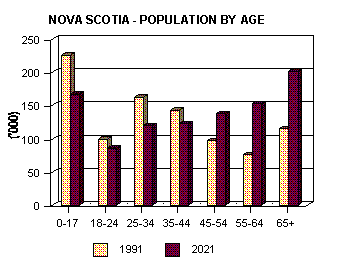Age and Sex Distribution
The declining number of births in the province over the past thirty years, in combination with extended life expectancy, has resulted in a notable shift in the age/sex structure of the Nova Scotia population. Between 1971 and 1995 the male proportion of the total population declined from 50.4% to 48.6%. This occurred despite the fact that males outnumbered females by approximately 5% at birth. The explanation for this shift lies in the increasing proportion of the population which is sixty-five years of age and over. Due to the longer life span for females, they comprise 58.3% of the 65+ population group.
The young working population, aged 25 to 44 years, expanded notably between 1971 and 1995, from 22.6% to 32.5% of the total population. Their numbers will decline by the year 2021 and 25 to 44 year olds will represent less than 25% of the total provincial population in that year. The middle age and older worker group (45 to 64 years) increased from 18.9% to 21.1% of the total population between 1971 and 1995 and will exhibit notable growth in the next 25 years, to comprise 29.4% of the population by the year 2021.
In 1971 the median age of the Nova Scotia population was 25.4 years. By 1995 this increased to 35.1 years and, by the year 2021, it will exceed 45 years and could approach 50 years.
A recent report by Statistics Canada (Growing Old in Canada -Cat. 96-321) said that "most of Nova Scotia, Cape Breton and the Gaspe Peninsula will have census divisions where, by 2011, over 18% of the population is projected to be aged 65 and over." This report also projected that by the year 2011 there would be almost 9,000 persons in Nova Scotia living in institutions, a further 21,200 with severe disabilities and an additional 28,200 with moderate disabilities. These numbers represent growth rates of approximately 60%, 45% and 38%, respectively, over the 1991 levels. This Canadian study concluded that "if an effective policy of deinstitutionalization is in place, or if the number of institutional spaces grows more slowly than the elderly population, then the increased number of elderly with severe and multiple disabilities living in the community will put even more pressure on them and on their families, friends and communities to support them. ....The question we must face today is whether the public policies adopted now will create equality of services or service-rich and service-poor elderly and communities in the future."

